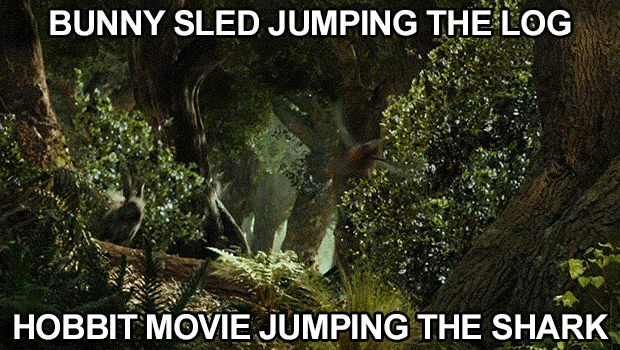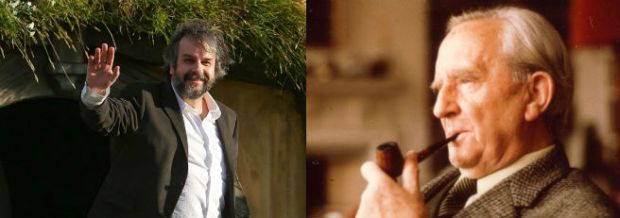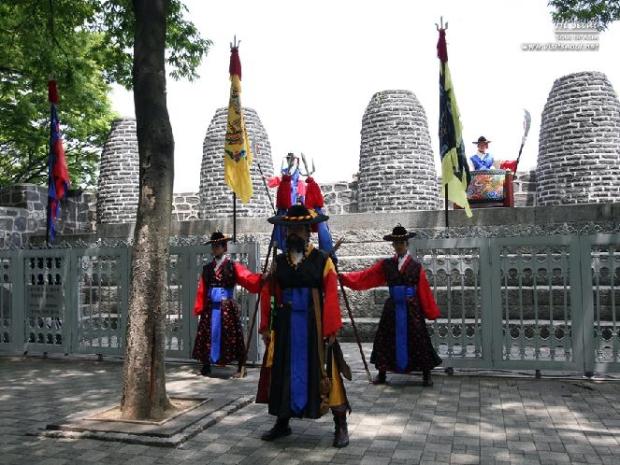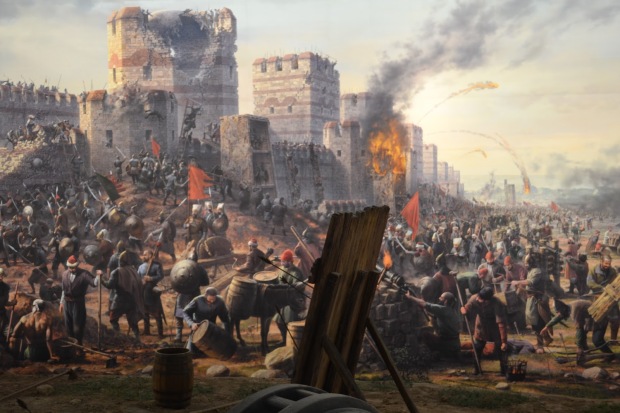A few weeks ago, on a typically splendid late-fall weekend here in Busan, I climbed Hwangnyeong Mountain, one of the many small peaks that jut up above the dense, concrete sprawl of this port city on South Korea’s southern tip. At the top, I experienced a neat bit of déjà vu, or synchronicity, or what-have-you. I remembered the first time I climbed Hwangnyeong-san, way back in 2003, during my first year in Korea. This was just a few weeks before The Return of the King—the third of Peter Jackson’s Lord of the Rings movies—came out in South Korea. Now it’s 2014, and I realized my recent climb once again coincides with the release of part three of another Jackson-directed J.R.R. Tolkien trilogy—this time, The Hobbit: The Battle of the Five Armies, hitting theaters on December 17.
And there’s an even bigger Hwangnyeong-san / Tolkien connection—the bongsudae. Bongsudae are the mountain-top fire beacons built by Chosun Dynasty kings in the 15th and 16th centuries that relayed messages up and down the peninsula, mostly having to do with foreign invasion, which happened all too frequently. The bongsudae system, at its height, had 673 towers that stretched from Busan all the way up to what is now Seoul. Usually the bongsudae consisted of 5 separate chimney-like pots or bowls, each about 3 meters high, made of stone or brick. The usual practice was one beacon remained lit as an “all clear.” Two fires meant an enemy was sighted. Three meant the enemy was nigh. Four meant the border had been breached, and five meant a battle was underway. A signal fire lit in Busan took about 12 hours to make it all the way to the King’s palaces almost 500 km away in Seoul. Busan has two mountains with sets of these fire-beacons, Hwangnyeon-san and Ganbio-san in Haeundae.
Back in 2003, seeing the bongsudae gave me one of those little shivery thrills you get when something ancient and exotic (even though they were, alas, replicas, re-built in the 1970s) jumps out of the history books, amidst all the bustling, high-tech, 21th century modernity. However, it wasn’t just the thrill of seeming something super old and “Korea-y” as Mr. Motgol would put it. There was also a flash of recognition because bongsudae make a brief but memorable appearance in The Lord of the Rings.
As a geeky 13 or 14 year old, I read The Lord of the Rings literally to tatters. I think the copy of The Fellowship of the Ring my twin brother and I had eventually started around page 32 as the cover, then the table of contents, then the maps of Middle Earth, then much of chapter 1 got torn away from overuse. The fire beacons make their appearance early in chapter 1 of The Return of the King, as Gandalf and Pippen ride to the great city of Minas Tirith just as Sauron is about unleash his forces of darkness upon it. Approaching the city, they see the beacons lit along the mountains to the north, calling for aid from neighboring Rohan:
Gandalf cried aloud to his horse. “On, Shadowfax! We must hasten. Time is short. See! The beacons of Gondor are alight, calling for aid. War is kindled. See, there is the fire on Amon Din, and flame on Eilenach; and there they go speeding west: Nardol, Erelas, Min-Rimoon, Calenhad, and the Halifirien on the borders of Rohan.”
Pippen became drowsy again and paid little attention to Gandalf telling him of the customs of Gondor, and how the Lord of the City had beacons built on the tops of outlying hills along both borders of the great range, and maintained posts at these points where fresh horses were always in readiness to bear his errand-riders to Rohan in the North, or to Belfalas in the South. “It is long since the beacons of the North were lit,” he said.
So, only a few months after the cool experience of climbing Hwangnyeong-san and finding Korea’s version of Gondor’s fire beacons, I found myself plunked down in my seat at the Haeundae Megabox awaiting Peter Jackson’s version of The Return of the King. With the first two movies great beyond almost all expectations (even hard-core Tolkien fan-geeks like me were won over), my anticipation was high for the trilogy’s climax, stoked even higher by critics’ orgasmic reviews. As the theater lights dimmed, I idly wondered if the fire beacons of Gondor—Tolkien’s bongsudae—would make an appearance.
Well, not only did they make an appearance, but Peter Jackson took brilliant artistic license to turn the lighting of the fire beacons into one of the most majestic shots in the trilogy—a scene of pure chill-inducing wonder. Instead of showing some distant flickering lights on far-off mountain peaks while Gandalf delivers some awkward exposition filled with a long list of fictional mountain names (let’s face it—there’s a LOT of awkward exposition in The Lord of the Rings), Jackson follows his instinct for dramaticization over exposition. We get a scene set in Minas Tirith, where Gandalf orders Pippin to sneak up to city’s own fire beacon and light it surreptitiously, against the wishes of Lord Denethor, who is sunk in depression following the death of his son, Boromir. Once the fire is lit, we see the flames spring to life on the next closest mountain. And then . . . suddenly we jump to a soaring, eagle-eye view of fires leaping up along the ridges and peaks, one by one, some of the peaks jutting above the clouds. The camera thrillingly zooms in on one fire, then wheels around and as we pull away, the shot pans to the next peak, which suddenly blazes with fire, and so on, all the way until Aragorn, in Rohan, sees the last fire beacon and runs to alert King Theoden . . . and all of this accompanied appropriately grand, sweeping music. (Watch the full scene here.)
All of us in the theater were gob-smacked. I actually heard several Koreans near me gasp aloud in astonishment. The scene was jaw-dropping in its own context, but for Koreans, it was like a scene from their own rich, tragic history brought to spectacular life. “This is what it must have been like!” they must have thought. Over four hundred years ago, the Japanese invasion under General Hideyoshi approaching the coast, the fire signals leaping peak to peak all the way to Seoul–this is what it was like!
By now, countless vats of critical ink have been spilled detailing why the first two Hobbit movies were disappointing: the jarring discrepancies in tone; the unnecessary padding and stretching of a single medium-length novel into three lengthy epic films; the absurdly overdone action sequences. It was still nice to return to Middle Earth via the incredible landscapes of New Zealand, and the great Ian McKellan still completely owns Gandalf and Martin Freeman is perfect as the reluctant hero Bilbo. The first two Hobbit films are not as disastrously shit-tastic as the three Star Wars prequels, by any means, but disappointing nonetheless.
In comparing The Hobbit to The Lord of the Rings movies, I keep coming back to the bongsudae. Amid all the monsters and magic, what made Jackson’s Lord of the Rings movies so great was the rough verisimilitude that ran throughout the whole project. And by versimillitude, I mean the sense that the Korean movie goers had when watching the fire beacons of Gondor burst alight: that’s what it was like! In watching the Helm’s Deep and the Siege of Gondor battle scenes, you could think to yourself, “Wow, that’s what the Mongol siege of Baghdad was like,” or “that’s what a charge of heavy cavalry during the Crusades was like.” Even quiet scenes seem like they could have been reasonable facsimiles of medieval or Anglo-Saxon life. The Prancing Pony Inn at Bree seemed exactly the place where Chaucer and his travelling compansions might have stopped for the night on their way to Canterbury and had a story-telling contest. The Golden Hall of King Theoden in Rohan could have been an actual Viking mead-hall. The Shire itself, homeland of the Hobbits, was clearly a facsimile of Tolkien’s beloved rural English countryside that he no doubt saw being threatened by urban and suburban development, just like in the final chapters of The Return of the King. In other words, shit was cool ‘cause shit was based on real shit.
But then we get to The Hobbit films. The scenes that in The Lord of the Rings seem inspired by real medieval life now seem inspired by . . . Donkey Kong. Yes, I know that Tolkien’s The Hobbit was much lighter in tone than the later trilogy, and I understand the need, once they decided expand The Hobbit into three films, to provide satisfying climaxes for all three movies. But still, it became clear rather quickly that Jackson’s instincts as to what to include from the books, what to take out, what to conflate and condense, what to highlight, and what to flat-out invent—the instincts which had seemed so unerring in The Lord of the Rings films—had sadly deserted him and had been replaced with a video game mentality. Radagast’s sled pulled by rabbits and hedgehogs (Sonic the Hedgehog?) was the first clear sign that something was going horribly wrong. Then the scene in the underground Goblin kingdom made me groan with its slap-stick preposterousness. Then, in the second film we get the dwarves escaping from the Elven Halls in barrels—O.K., that was all well and good, straight from the book, really— but Jackson had to add an orc battle on top of that, with the elves shooting at the orcs while balancing on the dwarves’ heads or some crap like that. WHY?! And finally, we get the climax in which the dwarves try to subdue the dragon Smaug by firing up their old smelting and forging furnaces and machinery—a scene filled with too-clever-by-half Rube Goldberg-esque contraptions that was not in the book at all and seemed to serve no practical purpose but to make the audience, or at least the kids in the audience, go “Wow.”
Only it didn’t make me go “wow,” it made me groan and check my watch. Didn’t we all learn from some guy named Lucas that throwing as much CGI shit on the screen as possible is not what the audience really cares about? Why is it that the Death Star battle at the end of the original Star Wars and the battle on Hoth in The Empire Strikes Back far outstrip any of the action sequences in Episodes 6, 1, 2, and 3? It’s because the last battle in Star Wars was modeled on real fighter-plane aerial dog fights. And the awesome Imperial Walkers seemed a plausible way to actually attack an ice-bound rebel base, and the Snow-Speeders with their tow-cables seemed an actually plausible way to attack the Walkers. In other words, everything was in the service of the story. When I stop thinking, “Wow, Bilbo or Luke, or Frodo or whoever was sure lucky to get out of that mess,” and start thinking, “Wow, the dudes who designed that special effect sure are good at what they do,” that’s the wrong kind of “wow.” You’ve jolted me out of the dream that every fantasy/action/sci-fi movie is supposed be and reminded me of a bunch of very well-paid techno-geeks with models and matte-paintings and computers and blue-screens.
In any case, Peter Jackson already has my 10 bucks for The Hobbit: The Battle of the Five Armies. In a few weeks, I’ll find myself at Lotte Cinema, or Megabox, or CGV, hoping that this time Jackson just sticks to the damn book, and remembers that even the most far-out fantasy scenes need to be grounded in something real-world and historical, like Gondor’s fire beacons and the bongsudae. The dragon Smaug laying waste to the lake town? Perhaps Jackson used U.S. jets napalming Vietnamese villages as inspiration. The titular “five army” battle, with masses of dwarves, elves, men, eagles and orcs, plus a hobbit and a wizard, all going medieval on each others’ asses, should invoke, well, a real medieval battle. That battle should provide ample opportunity for that gritty battle-realism that was so stirring in The Lord of the Rings. But then again, even in those great battle scenes, we had ridiculous shit like dwarf-tossing and Legolas running up the trunks of elephants and a ghost-soldier army that looked like they came out of a Disney theme-park ride.
Well, whatever shit Jackson decides to throw on the screen, this’ll be our final big-screen romp through Middle Earth. This’ll be our final cinematic look at that fantasy world thought out with staggering depth by that Oxford Philology professor John Ronald Reuel Tolkien. That makes me a little sad—after all, so much of what Jackson gave us was great. So much of it measured up to or even surpassed what I saw in my head as a 13-year old with his nose buried in those books. After this last movie, we’ll have to just go back and read those books again. At least until Peter Jackson decides to film The Silmarillion. 




Recent comments